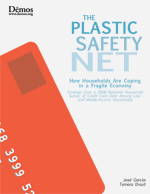Even before the downturn, millions of households were experiencing difficulties meeting the most basic expenses. Now, as families experience declining home values and tightened credit markets, many are falling behind on their mortgage and credit card payments. This report shows how skyrocketing costs, dwindling savings, stagnant wages and medical debt have forced low and middle-income families to turn to their credit cards as the de-facto safety net.
The report is based on a survey conducted between April and August 2008-consisted of 1,205 phone interviews with low- and middle-income households whose incomes fell between 50 percent and 120 percent of local median income; such households comprise roughly half of all households in the country.
TOP FACTS:
• Three quarters of low- to middle-income households reported using their credit cards as a safety net, relying on credit cards to pay for expenses such as car repairs, coping with job loss, or college expenses over the last three years.
• More than one out of three households used their credit cards to meet basic living expenses—such as rent, mortgage payments, groceries, utilities or insurance.
• More than half of indebted low- and middle-income households cited medical expenses as contributing to their credit card debt.
• The average credit card debt of low- and middle-income credit card indebted households in 2008 was $9,827, an increase from $9,536 in 2005.
• 48 percent of households said they had less debt than three years ago, while 42 percent reported having more debt and 10 percent reported having the same amount. Most households reported having swings in their debt—periods of paying down balances then accumulating them due to external events.
• 14.8 percent was the average interest rate paid on the card with the highest balance. But many households pay much more than the average: one in four households reported paying 20 percent interest or more on their card with the highest balance.

